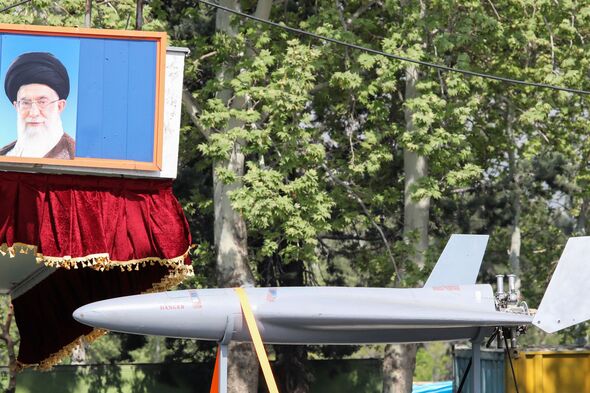IRAN’s newest kamikaze drones contain Chinese guidance systems, MoD scientists have found.
It follows extensive examination of an Iranian Arash-2 kamikaze drone which was recovered in the Negev desert after Tehran attacked Israel three weeks ago.
And the same sophisticated systems are “most likely” being used to assist Russia’s war effort in Ukraine, sources added last night.
The discovery is beieved to have contributed to last week’s imposition of new US sanctions on Chinese firms accused of supporting Russia’s war machine
Now Britain and the US have embarked on a joint project to counter these guidance systems.
The state-of-the-art Arsah-2 usually disintegrates upon impact. That it was found intact suggests that it ran out of fuel and that its warhead may have malfunctioned.
Little was known about it in the West other than Iranian claims that it possesses a loitering range of 1,300 miles- enabling it to comfortably hit Israeli targets – and carries a large warhead.
Scientists at the MoD’s top secret Defence Science and Technology Laboratory (Dstl) in Porton Down, Wiltshire, have spent the last two weeks poring over every inch of the captured 4.5 meter long killing machine.
Their task has been to establish where its crucial components are from, and whether its design contains vulnerabilities which can allow it to be shut down in flight.
Both objectives have now been achieved,
One of the most significant discoveries was that the UAV’sguidance system contained “Chinese markings”.
And this was no off-the-shelf system used for civilian drones, sources say.
Israel and its allies- including RAF Typhoons based in Cyprus – managed to down 99 per cent of the 170 drones, 120 ballistic missiles and 30 cruise missiles fired by Iran towards Israel on April 13.
But the Arash-2 UAV – aimed at a desert air force base – and a ballistic missile containing the Chinese components made it through Israel’s “Iron Dome” air defence net.
“This finding is significant, in that it confirms that China is playing a far larger role in militarising Iran than had been suspected,” said a source last night .
But there is a Russian element, too, which makes this discovery crucial.
Iran has supplied Russia with less capable kamikaze drones to attack Ukrainian civilian targets, and has also advised Moscow on how to circumvent the international sanctions it faces as a result of its actions.
But claims by Tehran that it had not given Russia Arash-2 technology for fear it would “end in US hands” may not be accurate.
“We now believe it is most likely that this guidance system is being used in UAVs launched by Russia. This shows how far China is willing to go in Ukraine, where it has steadfastly denied any involvement,” said the source.
Countermeasures to the guidance system – probably in the form of a jamming system – are being developed in a joint US-UK project, but will take at least two months to come on line.
“We won’t know if these will work until they are tried and tested,” the source added.
In 2023 the US charged a Chinese national working for China -based Sinotech Dalian Carbon and Graphite Manufacturing Corporation for helping Iran buy parts for its ballistic missiles.
And last week the US imposed new sanctions on Chinese companies – including a Chengdu-based firm accused of exporting drone parts to Russia and a Hong Kong-based firm accused of supplying parts found in Russian missile systems and UAVs.
Justin Crump, ceo of Sibylline strategic risk group, said: “We cannot underestimate the effect which drones have had on the war in Ukraine. They have paralysed battlefield manoeuvres in the same way as the machine gun did in the First World War.
“This is no off-the-shelf GPS chip that you can buy from Amazon. It’s a guidance system from the Chinese military, and it certainly crosses the sanctions threshold, whatever Beijing may say about its neutrality.’
